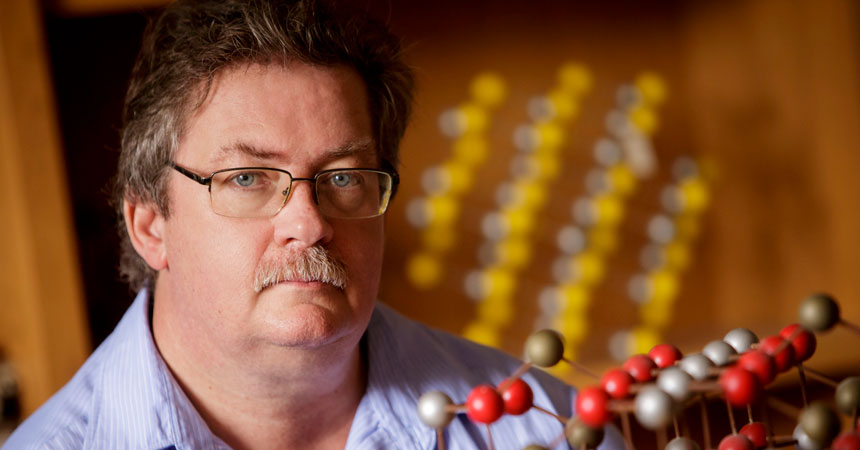20 Years On
Tuesday, March 21, 2017

When Allen Apblett was growing up in the Canadian provinces of Alberta and New Brunswick, his father often put on Merle Haggard records for the Sunday soundtrack. However inspirational the music, it was not “Okie from Muskogee” that brought Apblett to Oklahoma. Instead, it was a restless curiosity rooted in chemistry. As he enters his 20th year at Oklahoma State University, Apblett has proven himself as an educator, researcher and inventor.
The National Association of Inventors inducted Apblett as a fellow on April 15 at the U.S. Patent Office in Washington, D.C. Though he has garnered an enviable number of awards and grants throughout his career, the NAI ceremony was humbling for Apblett.
“I wasn’t sure I fit the crowd,” he laughs.
NAI fellows produce an average of 33 patents and Apblett lands on the lower side of that number. But quality over quantity counts: “A patent does not really mean much unless somebody uses it,” he notes.
He co-founded (along with OSU chemistry department head Nick Materer and OSU graduate Shoaib Shaikh) Xplosafe, which primarily produces products to test for and neutralize explosives and to purify water.
Just as importantly in Apblett’s eyes, Xplosafe has helped attract several Small Business Innovation Research grants from Homeland Security, USDA and the Department of Defense, creating opportunities for his OSU students. These grants provide seed money for small businesses specializing in technology commercialization. Apblett calls the grants critical to innovation because of their flexibility.
“With SBIR grants you can make the argument that an idea should be tried, instead of having five people tell you something won’t work,” he explains.
The availability of such seed money was a major attraction for Apblett when he arrived at OSU in 1997. Much of his success has come from seeking an answer to a question and simply following where it leads.
“My research has taken me so many different ways,” he says.
For example, how could he have guessed delivering a lecture in Texas would land him in Saudi Arabia for a week each year? That journey began when Apblett’s post-doc advisor at Harvard University went to Rice University just as Apblett was moving from Tulane University to OSU. On the way to Stillwater, Apblett gave his lecture at Rice, and an attendee from Saudi Arabian Basic Industries Corp. soon sent a student to study under him at OSU.
The relationship has since blossomed, and Apblett has welcomed a stream of Saudi students.
Apblett estimates the number of his former students in academia and industry at 50-50. One of the latter includes Cody Cannon, a senior research scientist at Magnesium Products in Tulsa, who credits Apblett’s success as a researcher and instructor to the academia-industry duality of his approach.
“He gives students a broader understanding of chemistry through different methods of instruction,” Cannon says. “He has so many different ideas, if you’re ready to take on more projects, he will encourage you.”
Cannon recalls Apblett always making time for students, even those in other groups.
“He’s very open and helpful,” he says.
Following a career in chemistry must have barely registered on young Apblett’s radar, though. His father was a military man (Apblett is a self-described “base brat”) who thought his sons could only be successful in one of two ways — sports or the Air Force.
“Unfortunately, I inherited his ability for sports and I can’t take orders,” Apblett jokes. While his brother followed his father into the military, Allen earned a degree with honors at the University of New Brunswick and a doctorate from the University of Calgary. Following a two-year postdoctoral fellowship at Harvard, he landed at Tulane in New Orleans.
Though he enjoyed his colleagues and the school itself, Apblett began to search for a place he could comfortably raise his family and a university where he could really dig into research. OSU proved to be the perfect place. He recalls learning the chemistry department had obtained a new piece of equipment but they needed more space — so OSU built a building.
“I thought if this place was willing to support research like that, it was the place to be,” Apblett says.
He quickly found the research infrastructure (help with budgets, paperwork, etc.) a welcome change. Additionally, the quality instrumentation available to undergraduates and the availability of seed money proved that OSU was dedicated to research. Even better, he was able to step into a lab tailored to his interests from the start and quickly built collaborations with the engineering college.
“At this point in my career, nobody will chastise me for working on a little bit of everything,” Apblett says. As of mid-2016, he was trying to solve problems with aircraft, production of chemicals for medical applications and working on kits for measuring chemicals in oil fields. He is even collaborating with faculty members from other universities on solar energy harvesting.
“There’s nothing like going in having little clue what the people are doing and then trying to solve their problems. You both learn something new and manage to accomplish something that will make a lasting impact.”
Photo Courtesy / Gary Lawson / University Marketing
Story by Brian Petrotta
